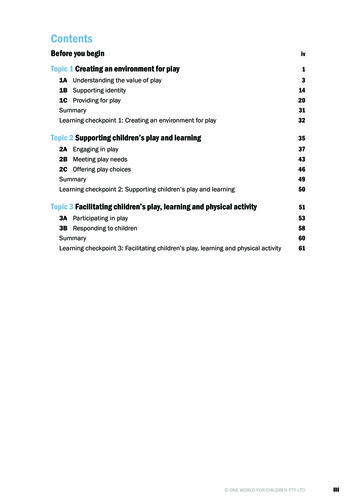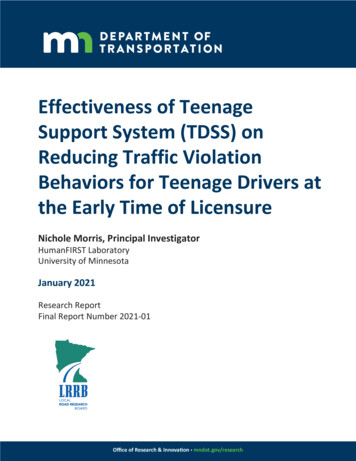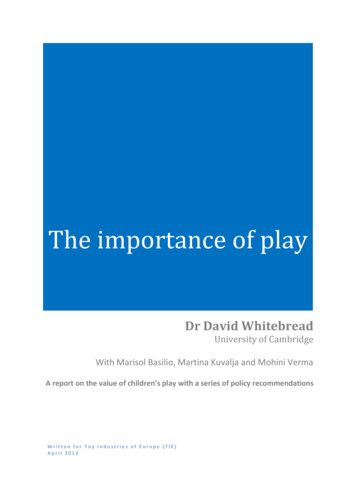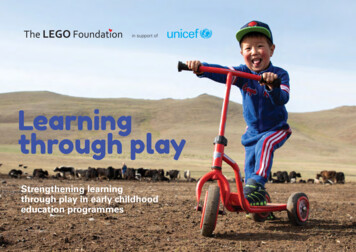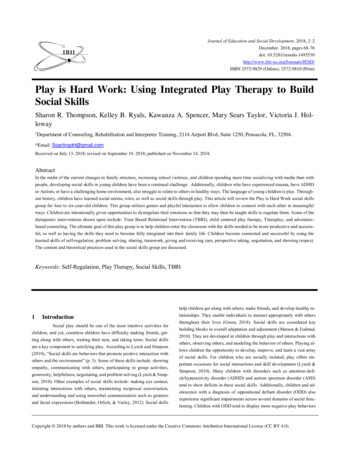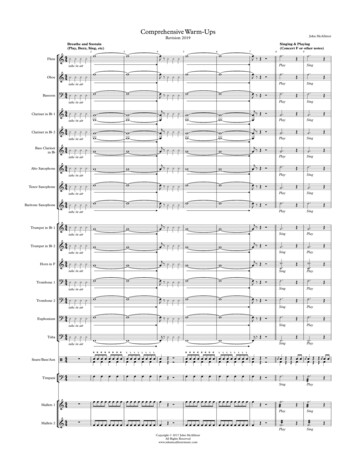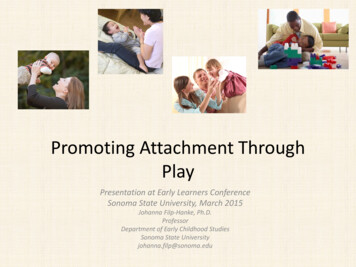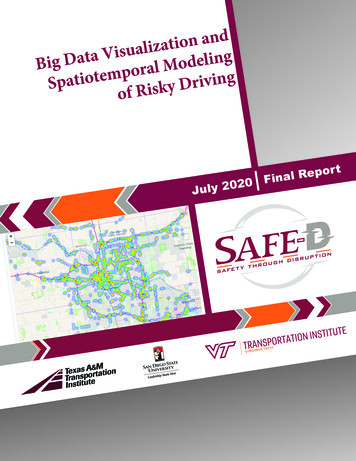
Transcription
Child Indicators Research (2021) 9804-5Risky Play and Children’s Well‑Being, Involvementand Physical ActivityOle Johan Sando1· Rasmus Kleppe2· Ellen Beate Hansen Sandseter1Accepted: 10 January 2021 / Published online: 17 February 2021 The Author(s) 2021AbstractChildren’s activities and experiences in Early Childhood Education and Care(ECEC) institutions are essential for children’s present and future lives. Playing is avital activity in childhood, and playing is found to be positively related to a varietyof outcomes among children. In this study, we investigated how risky play – a fundamentally voluntary form of play – related to children’s well-being, involvementand physical activity. Results from structured video observations (N 928) duringperiods of free play in eight Norwegian ECEC institutions indicated that engagement in risky play was positively associated with children’s well-being, involvementand physical activity. The findings in this study suggest that one way to supportchildren’s everyday experiences and positive outcomes for children in ECEC is toprovide children with opportunities for risky play. Restrictions on children’s playbehaviours following safety concerns must be balanced against the joy and possiblefuture benefits of thrilling play experiences for children.Keywords Risky play · Well-being · Involvement · Physical activity · ECEC1 IntroductionThere is little consensus regarding what should be the expected outcomes for children in Early Childhood Education and Care (ECEC). Unlike in school, children’soutcomes in ECEC are rarely delineated specifically to, for example, subject knowledge (Barnett et al. 2014). Instead, children’s outcomes in ECEC are suggested tobe foundational aspects of experience and learning (Laevers 2000), like well-being,social competence or emotional and cognitive development. These aspects areconsidered valuable in themselves and, simultaneously, a necessary basis for later* Ole Johan Sandoojs@dmmh.no1Queen Maud University College, Thrond Nergaards veg 7, N‑7044 Trondheim, Norway2Oslo Metropolitan University, Pilestredet 46, N‑0167 Oslo, Norway13Vol.:(0123456789)
1436O. J. Sando et al.learning (Hammer et al. 2017; Gupta and Simonsen 2010). While many researchers,educators, parents and policymakers are concerned with children’s outcomes concerning their future (e.g. school readiness) (Schleicher 2019), children themselveswould mainly consider the here-and-now value of their ECEC experience (Sandseterand Seland 2016; Koch 2018). This duality challenges researchers, practitioners andpolicymakers when it comes to establishing consensus around definitions and childoutcome measures in ECEC.In this study, we selected three outcomes on the child level: well-being, involvement and physical activity. We will argue that these outcomes account for essentialchildhood experiences and are related to future outcomes, and that it is timely to testtheir relation to the novel concept of risky play.1.1 Risky PlayThe concept of risky play comes from a relatively new line of research (Kvalnes2017). Risky play comes across as an oxymoron, combining the contradictory connotations of risk and play. Risk refers to the probability of a negative consequence(Rescher 1983), while play refers to a foundational, volunteer, inner-motivated and"purposeless" activity (Sutton-Smith 1997; Carse 1987). Thus, it seems unlikely thatanyone voluntarily and with purpose would expose themselves to a possible negative consequence. Notwithstanding, humans engage in such activities throughoutlife, and even from early childhood (Kleppe 2018; Breivik et al. 2017). Examples ofsuch activities include climbing, balancing, diving and downhill racing with skis orbicycles (Breivik et al. 2017).One explanation for such seemingly contradictory behaviour is that the rewardof a thrilling experience and mastering skills (often increasing difficult challenges)outweigh the potential negative consequences (Zuckerman 2009). When focusing onchildren, risky play is delineated to activities that entail excitement and uncertainty,and sometimes the possibility of injuries (Little 2010b; Sandseter 2010b). Typicalfor this type of play is that children willingly seek out situations they subjectivelyexperience as (moderately) dangerous.Risky play has been categorised into 1) Play with great heights – danger of injuryfrom falling, such as all forms of climbing, jumping, hanging/dangling, or balancingfrom heights; 2) Play with high speed – uncontrolled speed and pace that can leadto a collision with something (or someone), for instance bicycling at high speeds,sledging (winter), sliding, or running (uncontrollably); 3) Play with dangerous tools– that can lead to injuries, for instance, axe, saw, knife, hammer, or ropes; 4) Playnear dangerous elements – where one can fall into or from something, such as wateror a fire pit, 5) Rough-and-tumble play – where children can harm each other, forinstance, wrestling, fighting, fencing with sticks; 6) Play where children go exploring alone, for instance without supervision and where there are no fences, such as inthe woods; 7) Play with impact – children crashing into something repeatedly justfor fun; and 8) Vicarious play – children experiencing thrill by watching other children (most often older) engaging in risk (Sandseter and Kleppe 2019).13
Risky Play and Children’s Well‑Being, Involvement and Physical 1437Characteristically, children will express exhilaration, hesitation, fear or masterywhile playing with risk, and numerous repetitions are typical (Sandseter 2009b,2010a; Kleppe et al. 2017). Risky play thus represents the duality of childhoodexperience saliently: Children engage in risky play motivated by the thrilling experience itself, not because they want to become good at risk assessment. Regardless,their ability to assess risks will probably be strengthened through experience withrisk (Lavrysen et al. 2017).Children’s risk-taking in play appears to be universal, and risky play is observed invarious cultures globally (Sandseter et al. 2017; Brussoni et al. 2015). However, different cultures express tolerance for risk differently, and they tolerate different typesof risk. In Western societies, there are indications of a growing general risk averseness, both from parents and in ECEC institutions (Spiegal et al. 2014; Sandseter andSando 2016; Sandseter et al. 2017, 2019; Little 2010a). This risk averseness affectschildren’s possibilities for play and freedom negatively (Sandseter and Sando 2016;Spiegal et al. 2014), including lost potential benefits, both short- and long-term, ofrisky play (Brussoni et al. 2015; Sandseter and Kennair 2011; Lavrysen et al. 2017).1.2 Risky Play and Well‑BeingIn the framework of experiential theory, the main aim is to understand how eachchild is doing emotionally, socially and developmentally in any given setting(Laevers 2000). The framework relies on two concepts: well-being and involvement. Well-being is in this study defined as to what degree children feel at ease,acts spontaneously and show vitality and self-confidence (Laevers 2000). Accordingto Laevers (2000), such signals indicate how the child’s basic physical, emotionaland social needs are met. The approach to children’s well-being in the present studyemphasises children’s signals of discomfort or satisfaction and ties such signals totheir subjective well-being.Despite growing attention towards the importance of well-being in childhood,few studies have addressed the impact of ECEC institutions on children’s well-being(Holte et al. 2014). The importance of autonomy for children’s well-being in ECECwas demonstrated by Sandseter and Seland (2016), who found that having an influence on what to do, where to be, and whom to be with was essential. Koch (2018)found the experience of friendship, challenging activities and engagement in freeplay to be favourable approaches to well-being in ECEC institutions. The association between play and well-being is also established in other studies (Kennedy-Behret al. 2015; Giske et al. 2018; Howard and McInnes 2013). As such, risky play canbe expected to support children’s well-being in ECEC, following the notion thatchildren engage in this form of play of their interest, motivated by the thrilling andexciting experience of challenging activities.1.3 Risky Play and InvolvementIn Laevers’ (2000) framework, well-being is seen as a prerequisite for involvement.Involvement is in this study defined as the degree to which children have directed their13
1438O. J. Sando et al.attention, are engaged and concentrated in activities (Laevers 2000). If children’s basicneeds for well-being are not met, and they are not at ease, it is difficult for them toconcentrate and experience real involvement. Behavioural indicators of involvementare deep concentration, focus and engagement. Combined, well-being and involvementconstitute the concept of ’deep level learning’ (Laevers 2000). This concept contrastssuperficial learning, in that it describes how challenges must build on children’s existing competences, but also that their capabilities must be appropriately challenged. Suchlearning experiences build a necessary foundation for later learning.Play is a typical situation where children experience involvement. This idea followsthe characteristics of children’s play as being grounded in children’s interests and intrinsic motivation, attributes that can be expected to relate to engagement and concentration (Liu et al. 2017; Zosh et al. 2017). More so, if there is a risky aspect in the play,aspects of involvement tend to intensify (Sandseter 2010a). Thus, risky play is a typicalactivity where children can experience involvement.1.4 Risky Play and Physical ActivityPhysical activity is defined in the present study as any bodily movement produced bythe skeletal muscles that results in energy expenditure (Caspersen et al. 1985). Beingphysically active is strongly related to several health outcomes and is commonly considered to be one of the most potent ways to enhance an individual’s health across thelifespan (Haskell et al. 2009). Compared to less-active children, physically active children are found to have healthier cardiovascular profiles, to be leaner, and to develophigher peak bone mass (Boreham and Riddoch 2001), characteristics that may influence children’s health both in the present and in the future.A systematic review found general positive relations between risky play and varioushealth indicators, including physical activity (Brussoni et al. 2015). The excitement andrewarding thrill entailed in risky play is seemingly a strong motivation for children tobe physically active, e.g. climbing up and jumping down or rough and tumble (Sandseter 2010a; Engelen et al. 2013; Pellegrini and Smith 1998). This thrill is potentiallyalso a motivating factor contributing to the repetitiveness of many types of risky play(Sandseter 2010a; Kleppe et al. 2017). Thereby, risky play seems ideal for facilitating physical activity among children, within an intrinsically motivated context, wherechildren are active because they enjoy the activity. However, Brussoni et al. (2015)revealed that more research was necessary to validate the concept of risky play andpotential relations to other child health outcomes.1.5 Aim of StudyOn this background, we hypothesise that risky play is positively associated withwell-being, involvement and physical activity. These three outcomes are essential inECEC, both as a salient expression of children’s here-and-now experiences and fortheir future health and learning. The research question of this article is: What is theassociation between engaging in risky play and children’s well-being, involvementand physical activity in eight Norwegian ECEC institutions?13
Risky Play and Children’s Well‑Being, Involvement and Physical 14392 MethodsThis study was conducted as a sub-study within the project EnCompetence. Thestudy was funded by The Research Council of Norway, and approved by the Norwegian Social Science Data Services. The project is a three-year study using mixedmethods (Creswell 2013), placed within a design experiment in education framework (Cobb et al. 2003). The study is conducted in close collaboration with threeECEC owners in Norway, and the data collection involved systematic and randomised video observations of children. The conducted video observations weretaken during periods designated for free play, implying that children could decidewhat they wanted to do, where they wanted to be and with whom they wanted tointeract. The analyses in the present study are conducted on cross-sectional data collected in the fall of 2018. Previous studies from this study have demonstrated thatchildren’s play were associated with their well-being and involvement (Storli andSandseter 2019) and that the characteristics of the physical environment were associates with children’s well-being, physical activity and involvement (Sando 2019a,b; Storli et al. 2020; Sando and Sandseter 2020), This study differentiates from theprevious articles in that here the relationship between children’s engagement in riskyplay and their well-being, involvement and physical activity is explored.2.1 Procedure and SampleEight ECEC institutions were strategically selected among the partner institutions.The participating institutions were located in the south (N 4), middle (N 3) andnorth (N 1) of Norway, had between 58 and 117 children (Mean 85) and werebuilt between 1989 and 2016 (Mean 2007). Five girls and five boys in each institution were randomly selected among the three to five-year-olds, and informed, written consent to participate was obtained from the parents. The data collection wascarried out over one week in each of the participating institutions.With ten children in eight institutions participating, the data collection was supposed to include 80 children. However, one of the children was absent on the day ofobservation. Therefore, the sample in this study includes 79 children, 40 boys and39 girls, with a mean age of 4.7 years (SD 0.6) ranging from 3.8 to 5.8 years.The researchers in the project developed a strict protocol for the procedure forvideo observations to ensure a random sample of children’s activities. One ECECteacher from each institution was recruited as a co-researcher and was the one whoconducted the filming, to limit the impact on the children’s behaviour and to keepan ongoing dialogue with the children about the filming to ensure consent to participate. The researcher participating in the data collection wrote field notes andensured that the protocol was followed and a participant-as-observer role (Gold1957) was selected to serve this role. This role was distanced to reduce the impact onthe children’s and staff’s behaviour. If approached by children or staff, the researcherinteracted with them but was otherwise conscious of avoiding interacting with staffand children during observation periods. The preschool teacher conducted the actualfilming with a GoPro Hero action camera. The co-researcher was asked to regularly13
1440O. J. Sando et al.do video observations before the data collection so that the children were familiarwith being filmed. Cameras were also used for pedagogical documentation beforethis study in the participating institutions. Regular use of cameras before the datacollection and a familiar person filming with a small wide-angle camera were essential to film children closely enough to be able to capture speech, body language,and facial expression without affecting the children noticeably. Nevertheless, higherparticipant reactivity is a limitation commonly associated with video observations inbehavioural studies (Haidet et al. 2009).Two children were observed each day. The first child was filmed for two minutes,followed by a six-minute break. Then, the other child was filmed for two minutes,followed by another six-minute break. This alternation was repeated until six videoobservations were recorded of each child in the indoor and outdoor environment. Ifa child was in situations in which filming was not an option due to ethical considerations, the video observation was postponed. The co-researcher avoided filming insensitive situations and kept an ongoing dialogue with the children about the filmingto ensure assent to participation.A complete sample of 12 observations for 79 children would include 948 twominute video observations. However, the final sample only includes 928 observations. Hence, 20 observations are missing. Missing observations occurred becausechildren were picked up by their parents, or they were excluded because the childwas hidden from view, was preoccupied with the camera, or a technical or humanerror occurred. The number of missing video observations is low and does not represent a methodological challenge for the present study.2.2 MeasuresThe Leuven Well-Being Scale (Laevers 2005) was used to measure the well-beingof the children. The scale, which is designed for observing children individuallyfor two minutes, scores children’s level of well-being on a scale from one to five.Laevers and Declercq (2018) describe the five levels as follows: 1) Outspoken signsof distress, 2) Signs of distress predominate, 3) A mixed picture, no outspoken signs,4) Signs of enjoyment predominate, and 5) Outspoken signs of enjoyment.The Leuven Involvement Scale (Laevers 2000) was used to measure the involvement of the children. This scale is developed by the same group of researchers as thewell-being scale. It also ranges from one to five and is developed for observing anindividual child for two minutes. Laevers and Declercq (2018) describe the five levels as follows: 1) No activity, 2) Interrupted activity, 3) Activity without intensity, 4)Activity with intense moments, and 5) Continuous intense activity.The Observational System for Recording Physical Activity in Children–Preschool (OSRAC-P) (Brown et al. 2006) was used to measure the physical activityof the children. The classification of physical intensity in OSRAC-P used in thisstudy is based on the Children’s Activity Rating Scale (CARS) (Puhl et al. 1990),which has been psychometrically tested and found to demonstrate evidence of reliability (Puhl et al. 1990; Loprinzi and Cardinal 2011; Pate et al. 2010). The physical13
Risky Play and Children’s Well‑Being, Involvement and Physical 1441activity intensity is classified in five different levels: 1) Stationary or motionless, 2)Stationary with limb or trunk movements, 3) Slow, easy movements, 4) Moderatemovements, and 5) Fast movements (Brown et al. 2006).Two independent researchers scored the well-being, involvement and physicalactivity of the observed child in each video observation on Excel spreadsheets. Theproject researchers were trained to use and interpret the Leuven scales and manualsthrough digital video training. To enhance the consistency in the coding of all threeoutcome measures, workshops to adjust, recalibrate and identify challenges wereheld when each researcher had scored 24 observations. These clips were reviewedjointly and discussed to strengthen the internal consistency in the coding. Disagreements higher than one point were reviewed again and discussed in the researchgroup until a mutual understanding was reached. For differences of one point, anaverage of the two scores was used. This choice implies that the scores for the outcome variables in the analysis were a nine-point scale, still ranging from one tofive but also with intervening half scores (1.5, 2.5, 3.5, 4.5). In other words, thedependent variables in the analysis were treated as an interval scale, where the distance between scores was considered equal. Using weighted kappa (Cohen 1968),inter-rater agreement was 90% for well-being, with a kappa value of 0.50. A similaragreement was found for involvement, with 90% agreement and a kappa value of0.58. Kappa values in this range indicate moderate agreement (Viera and Garrett2005). For physical activity, the inter-rater agreement was 94%, with a kappa valueof 0.73, indicating substantial agreement (Viera and Garrett 2005).Risky play was coded using the Observer XT 12.5 behaviour coding (Noldus),analysis and management software for observation data (Zimmerman et al. 2009).This software allows for the second-by-second coding of videos, meaning that theresearchers were able to code instances and duration of the various types of playbehaviour. Three assessors independently coded a part of the video material according to recent categories of risky play (Sandseter and Kleppe 2019): 1) Play withgreat heights, 2) Play with high speed, 3) Play with dangerous tools, 4) Play neardangerous elements, 5) Rough-and-tumble play, 6) Play where children go exploringalone, 7) Play with impact, and 8) Vicarious risk. In the analysis, a merged variable describing the sum of these categories was used to investigate the associationbetween total engagement in risky play and the three outcome variables. The prevalence of the sub-categories describing risky play is previously published (Sandseteret al. 2020).Workshops and discussions among the researchers were held to ensure similaruse and interpretation of the categories. The assessors aimed to evaluate the child’sexperience of risk in their activities, which may be identified through the child’s positive and negative emotion, motor behaviour and verbal and bodily expressions. Thisimplies that no "objective" level of riskiness was set; instead, the child’s subjectiveexperiences of risk were interpreted and determined based on observable verbal andbodily expressions and actions. Internal consistency in the coding between assessors was confirmed by cross-checking 80 observations among the 256 observationsin which risky play was coded. In 59 of these observations (74%), no comments tothe initial coding were made. In 15 of the observations (19%), comments on whento start or stop the coding of a specific category were made. In 6 observations (7%),13
1442O. J. Sando et al.comments on what category of risky play that was most appropriate to use weremade. The 21 observations with comments were reviewed jointly by all three assessors to discuss the second assessors’ comments and to reach a mutual understandingof the use of categories and when to start or stop coding. Only minor adjustments tothe full sample were needed following this evaluation of the measure, and the internal consistency was considered to be satisfying.2.3 AnalysisThe risky play codings from Observer XT were exported, paired with the spreadsheet of scores for well-being, involvement and physical activity, and imported toStata MP 15.1 (StataCorp, College Station, TX, USA), which was used for the statistical analysis. Given the hierarchical structure of the data with nested observations of children within ECEC institutions, multilevel regression analysis (Goldstein1986) was used to investigate the associations of risky play and children’s wellbeing, involvement and physical activity. Linear mixed models, specifically random intercept models, were used in all multilevel analysis. The multilevel analysismakes it possible to control the nested data structure as well as other variables andincreases the accuracy of the predictions (Gelman 2006).3 ResultsThe mean duration of the 928 video observations was 122 s (SD 4). The averageamount of risky play in these observations was 12% (SD 27). The average scorefor well-being was 3.8 (SD 0.7), involvement was scored 3.7 (SD 0.8) on average, whereas physical activity was scored 3.1 (SD 0.9) on average. The 928 videoobservations were equally distributed among boys (N 470) and girls (N 458)and between the indoor environment (N 464) and outdoor environment (N 464).Table 1 presents descriptive statistics for the key variables.The correlation matrix presented in Table 2 shows that risky play is positivelycorrelated with well-being (r 0.27, p 0.001), involvement (r 0.19 p 0.001),and physical activity (r 0.44, p 0.001).Multilevel regression analysis was applied to analyse the association betweenrisky play and the outcome variables well-being, physical activity and involvement.This analysis was used to control for the nested data structure and the children’s ageand gender. Random intercept models were used in all multilevel analysis. The datawere nested at three levels: observation level (level 1) (N 928), child-level (level2) (N 79) and institutional level (level 3) (N 8). The variance partition coefficient(VPC) was used to determine the number of levels in the model (Mehmetoglu andJakobsen 2017). VPC calculations for well-being indicated that there was a 6% variance at the institutional level and 20% variance at the child level. Similar varianceswere found in involvement, with a 5% variance at the institution level and 17% variance at the child level. For physical activity, there was a 0% variance at the institution13
Risky Play and Children’s Well‑Being, Involvement and Physical Table 1 Descriptive statistics(N 928 observations)1443MeanSDMinMaxAge4.70.63.85.8Risky Physical activity3.10.915Table 2 Correlation matrix (N 928 observations)1234561. Age—2. Boy (0 girl)0.12***—3. Risky play0.050.03—4. Well-being0.060.07*0.27***—5. Involvement0.08*0.06*0.19***0.76***—6. Physical activity0.07*0.08*0.44***0.38***0.28***—* p 0.05: ** p 0.01: *** p 0.001level and a 5% variance at the child level. Two-level models were selected for further analysis, following the limited amount of variance at the institutional-level.Well-being, involvement and physical activity were used as dependent variablesin the analysis to investigate the association with risky play. Stepwise inclusionof variables starting at the lowest level in the model (Hox 2010) was performed,implying that the variable describing the amount of risky play in the observationwas added first, before children’s age and gender. An intercept-only model was runfirst (M0), followed by a model including a variable describing the amount of riskyplay in the observation (M1). Lastly, the second-level variables describing children’sage and gender were added to the model (M2). Deviance, Akaike’s Information Criterion (AIC) and Schwarz’s Bayesian Information Criterion (BIC) are presented toindicate how well the model fits the data and to compare the final model to the intercept-only model (Hox 2010). Tables 3, 4 and 5 present M0, M1 and M2 for wellbeing, involvement and physical activity.The final models (M2) indicate that there is a positive association between engaging in risky play and children’s well-being, involvement and physical activity. Thesize of the coefficients and the explained variance after including the variable forrisky play in the models indicate that risky play is most strongly related to children’sphysical activity. However, substantial associations were also found with well-beingand involvement.Children’s well-being is estimated to be 0.6 higher on the Leuven Well-beingScale when children engage in risky play for the entire observation (100% of thetime). There is no significant association between gender, age and well-being. Forwell-being, M1 are a significantly (p 0.001) improved model compared M0 using alikelihood-ratio test, while M2 is no significant improvement compared to M1.13
O. J. Sando et al.1444Table 3 Models for well-being (N 928 observations)ModelM0: Well-beingM1: Well-beingM2: Well-beingFixed partCoeff. (Robust SD)Coeff. (Robust SD)Coeff. (Robust SD)Intercept3.84 (0.04)3.77 (0.05)3.48 (0.28)0.006 (0.001)***0.006 (0.001)***Risky playAge0.05 (0.06)Boy0.08 (0.07)Random partLevel 1 Var0.35 (0.02)0.33 (0.02)0.33 (0.02)Level 2 Var0.09 (0.02)0.08 (0.03)0.07 401751*p 0.05, **p 0.01, ***p 0.001Table 4 Models for involvement (N 928 observations)ModelM0: InvolvementM1: InvolvementM2: InvolvementFixed partCoeff. (Robust SD)Coeff. (Robust SD)Coeff. (Robust SD)Intercept3.69 (0.05)3.63 (0.05)3.10 (0.31)0.005 (0.001)***0.005 (0.001)***Risky playAge0.11 (0.07)Boy0.09 (0.09)Random partLevel 1 Var0.57 (0.03)0.56 (0.03)0.56 (0.03)Level 2 Var0.11 (0.02)0.10 (0.02)0.09 052215*p 0.05, **p 0.01, ***p 0.001Involvement is estimated to be 0.5 higher on the Leuven Involvement Scale whenchildren engage in risky play for the entire observation. There is no significantassociation between gender, age and involvement. M1 are a significant (p 0.001)improvement compared to M0 for involvement model using a likelihood-ratio test.For involvement, M2 is no significant improvement compared to M1.Physical activity is estimated to be 1.4 higher on the OSRAC-P scale when children engage in risky play for the entire observation. Similar to the child’s well-beingand involvement, there is no significant association between gender, age and physical activity. For physical activity, M1 are a significantly (p 0.001) improved modelcompared M0 using a likelihood-ratio test, while M2 is no significant improvementcompared to M1.13
Risky Play and Children’s Well‑Being, Involvement and Physical 1445Table 5 Models for physical activity (N 928 observations)ModelM0: Physical activityM1: Physical activityM2: Physical activityFixed partCoeff. (Robust SD)Coeff. (Robust SD)Coeff. (Robust SD)Intercept3.05 (0.04)2.89 (0.03)2.54 (0.25)0.014 (0.001)***0.014 (0.001)***Risky playAge0.06 (0.05)Boy0.10 (0.06)Random partLevel 1 Var0.69 (0.04)0.56 (0.03)0.56 (0.03)Level 2 Var0.04 (0.01)0.02 (0.01)0.02 542163*p 0.05, **p 0.01, ***p 0.0014 DiscussionThe findings in this study demonstrated that children’s engagement in risky play waspositively associa
be physically active, e.g. climbing up and jumping down or rough and tumble (Sandse-ter 2010a; Engelen et al. 2013; Pellegrini and Smith 1998). This thrill is potentially also a motivating factor contributing to the repetitiveness of many types of risky play (Sandseter 2010a; Kleppe et al. 2017). Thereby, risky play seems ideal for facilitat-
